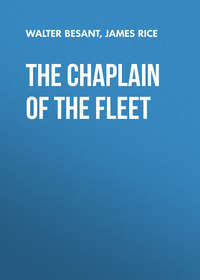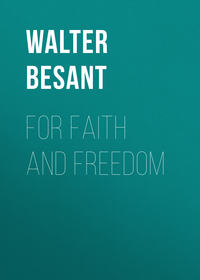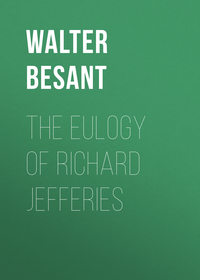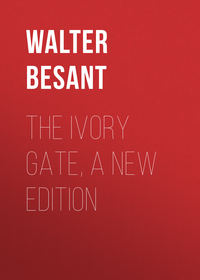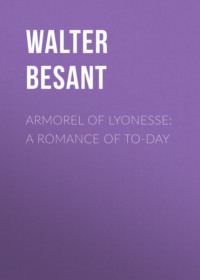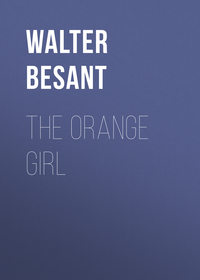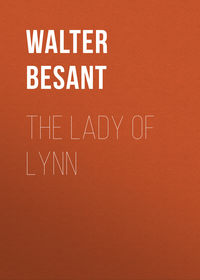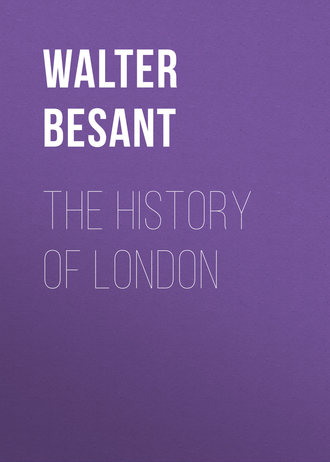 полная версия
полная версияThe History of London
On the south side of Paul's Churchyard we pass in succession the beautiful Chapter House: the Church of St. Gregory and the Deanery. Close to the western gate are residences for the Canons, south of the enclosure are the Cathedral Brewhouse and Bakehouse.
Such are some of the buildings in Paul's Churchyard. The Cathedral establishment supported a great army of priests and people. For many of them, perhaps for most, there were residences of some kind either within the enclosure or close beside it. Thus the priests, including Bishop, Dean, Archdeacons and Canons, a hundred and thirty in number: then there were the inferior officers: yet persons of consideration and authority, such as Sacrist, Almoner, Bookbinder, Chief Brewer, Chief Baker, with all their servants: scribes, messengers, bookbinders, illuminators and copyists: singing-men and choir boys, and women to keep the church clean. When we add that the Brewer had to provide 200 gallons of beer a day, it is obvious that there must have been a good many people belonging to the Cathedral who lived in the enclosure called the Churchyard.
26. THE RELIGIOUS HOUSES
If we take a map of London in the fourteenth century and lay down upon it all the monasteries and religious Houses that then existed we shall find twenty, all rich and splendid Foundations, without counting those of Westminster and the villages within a few miles of London Stone. These were built for the most part either just within or just without the City wall. The reason was that the City was less densely populated near the wall than lower down along the river-side. Every one of these Societies was possessed of estates in the country and streets and houses in the City. Every one then retained, besides the monks or friars and nuns, a whole army of officers and servants. A great monastery provided employment for a very large number of people. In every separate estate which belonged to it, the monastery wanted tenant farmers, foresters and hunters, labourers, stewards and bailiffs, a curate or vicar in charge of the church and all the officers who are required for the management of an estate. For the House itself there were wanted first, the service of the chapel, apart from the singing which was done by the brethren: the school: the library: lawyers and clerks to administer the estates and guard the rights and privileges of the House: the brewhouse, bakehouse, kitchen, cellar, stables, with all the officers and servants required in a place where everything was made in the house; the architects, surveyors, carpenters and people wanted to maintain the buildings. It is not too much to reckon that a fourth part of the population of London belonged in some way or other to the monasteries, while these Houses were certainly the best customers for the wines, silks and spices which were brought to the quays of Queenhithe and Billingsgate.
It is generally believed that the monasteries, besides relieving the sick and poor and teaching the boys and girls, threw open their doors readily to any poor lad who desired to take the vows of the Order.
All this is a misconception: there were the same difficulties about relieving the poor as there are with us at the present moment. That is to say, indiscriminate charity then, as now, turned honest working men into paupers. This the monks and friars understood very well. They were therefore careful about their charities. Also in many Houses the school was allowed to drop into disuse. And as regards the admission of poor boys it was done only in cases where a boy showed himself quick and studious. It has been the glory of the Church in all ages that she has refused to recognise any barrier of birth: but she has also been careful to preserve her distinctions for those who deserve them. Most of the brethren in a rich Foundation were of gentle birth and good family. If a poor boy asked to join a monastery he was lucky if he was allowed to become one of its servants and to wear its livery. Then his livelihood was assured. There is every reason to believe that the rule of the brethren, strict for themselves, was light and easy for their servants. You may find out for yourselves where the London monasteries were, by the names of streets now standing on their sites. Thus, following the line of the wall from the Tower north and west you find St. Katharine's Dock where stood St. Katharine's Hospital: the Minories marks the House of the Minorites or Sisters of St. Clare; Great St. Helens is on the site of St. Helen's Nunnery: Spital Square stands where St. Mary's Spital formerly received the sick: Blackfriars, Charter House and Bartholomew's still keep their name: Austin Friars is the name of a court and the Friars' Church still stands: Whitefriars is still the name of a street: Grey Friars is Christ's Hospital: the Temple is now the lawyer's home; part of the Church of the Knights Hospitallers is still to be seen. Three great Houses, it is true, have left no trace or memory behind. Eastminster or the Cistercian Abbey of St. Mary of Grace, which stood north of St. Katharine's, and was a very great and stately place indeed: the Priory of the Holy Trinity, which stood where is now Duke's Place, north of the church of St. Catharine Cree: and St. Mary of Bethlehem, which stood just outside Bishopsgate. The memory of Bermondsey Abbey and St. Mary Overy on the south side of the river has also departed, but the church of the latter still stands, the most beautiful church in London next to Westminster Abbey.
But besides all these religious Houses employing thousands of people, there were in the City of London no fewer than 126 parish churches. Many of the parishes were extremely small – a single street – or half a street: many of the churches were insignificant: but many were rich and costly structures, adorned and beautified by the piety of many generations: all were endowed with funds for the saying of masses for the dead, so that there were many priests to every parish. Consider these things and you will understand that the City was filled with ecclesiastics – priests, friars, servants of the Church: at every corner rose a church: to one standing on the other bank of the river the City presented a forest of spires and towers. The church then occupied a far larger part of the daily life than is now the case even with Catholic countries. All were expected to attend a daily service: the trade companies went to church in state: young men belonged to a guild: the ringing of the bells was never silent: no one could escape, if he desired, from the Church. No one did desire to escape, because every one belonged to the Church. You must understand, not only that the Church was so great and rich that it owned and ruled a very large part of the country, but also that the people all belonged to the Church: it was part of their life as much as their daily work, their daily food, their daily rest.
27. MONKS, FRIARS, AND NUNS
We must not speak of monks indiscriminately as if they were all the same. There were as many varieties among the Orders as there are sects among Protestants and as much rivalry and even hatred of one with the other. Let us learn some of the distinctions among them.
Monks were first introduced into Western Europe in the year 529. There had long been brotherhoods, hermits, and solitaries in the East, where they existed before the Christian age. St. Benedict founded at Monte Casino in Campania a monastery for twelve brethren in that year. The Benedictines are the most ancient Order: they have also been always the most learned. The Priory of the Holy Trinity in London was Benedictine. Several branches sprang out of this Order, mostly founded with the view of practising greater austerities. Among them were the Carthusians, a very strict Order – in London they had the Charter House, a name which is a corruption of Chartreuse, their original House: and the Cistercians, founded at Citeaux in France – they had Eastminster, or the Abbey of St. Mary of Grace. All these were monks.
The Augustine, or Austin Friars, pretended to have been founded by Augustine, but were not constituted until the year 1256. They had the monastery of Austin Friars in London. There were several branches of this Order.
There were next the three great Mendicant Orders, Franciscans, Dominicans, and Carmelites. These were the popular Orders. The monks remained in their Houses alone, separated from the world. The friars went about among the people. By their vows they were to possess nothing of their own: they were to sleep where they could: they were to beg their food and raiment: they were to preach to the people in the streets and in their houses: they were to bring the rites of the Church to those who would not enter the doors of the Church. None were to be too poor or too miserable for them. In their humility they would not be called fathers but brothers – fratres – friars. In their preaching they used every way by which they could move the hearts of the people; some thundered, some wept, some made jokes. They preached in the midst of the markets, among the sports of the Fair, wherever they could get an audience together.
The Franciscans, who had Grey Friars House, now the Bluecoat School, were founded by St. Francis of Assisi in the beginning of the thirteenth century. They came over to England and appeared in London a few years later. On account of their austerities and the faithfulness with which the earlier Franciscans kept their vows and the earnestness of their preaching they became very popular in this country. Their name – Grey Friars – denotes the colour of their dress. The old simplicity and poverty did not last long. It must, however, be acknowledged that wealth was forced upon them.
The Dominicans were founded by St. Dominic about the year 1215. Sixty years later they came to London and established themselves in the place still known by their name – Blackfriars. Their dress was white with a black cloak. They were never so popular as the Franciscans perhaps because they insisted more on doctrine, and were associated with the Inquisition.
The third of the Mendicant Orders was the Carmelite. They were the Whitefriars, their dress being white with a black hood. Their House was in Fleet Street. Here was a sanctuary whose privileges were not abolished till the year 1697.
Other Orders represented in London were the Cluniacs, a branch of Benedictines – they had the Abbey of St. Saviour in Bermondsey; the Black Canons, established at St. Bartholomew's: the Canons Regular of St. Augustin – who had the Southwark Priory of St. Mary Overie: the Knights Templars; and the Knights of St. John.
As a general rule it is enough to remember that the monks were Benedictines with their principal branches of Carthusians, Cistercians, and Cluniacs: that the friars were those named after Augustine, Dominic, Francis, and Mount Carmel; that the monks remained in their Houses, practising a life of austerity and prayer – so long as they were faithful to their vows: and that the friars went about among the people, preaching and exhorting them.
Of the nunneries some were Benedictine, some Franciscan: that of the Minorites belonged to the latter Order: that of St. Helen's, to the former.
The Religious Houses were dissolved at the Reformation. You must remember that if it had not been for the existence of these Houses, most of the arts, science, and scholarship of the world would have perished utterly. The monks kept alive learning of all kinds: they encouraged painting: they were discoverers and inventors in science: they were the chief agriculturists and gardeners: they offered an asylum to the poor and the oppressed. 'The friendship of the poor,' said Bernard, 'makes us the friends of Kings.' And in an age of unrestrained passions they showed an example of self-restraint and austerity. The friars did more: they were poor among the poor: no one was below their care and affection: they had nothing – they would take nothing – at first: till the love and gratitude of the people showered gifts upon them and even against their will, if they still retained any love for poverty, they became rich.
28. THE LONDON CHURCHES
Before the Great Fire of London there were 126 churches and parishes in the City. Most of these were destroyed by the Fire, and many were never rebuilt at all. Two or even three and four parishes were united in one church. Of late years there has been a destruction of City churches almost as disastrous as that of the Fire. Those who have learned from this book, and elsewhere, to respect the monuments of the past and to desire their preservation, should do their utmost to prevent the demolition of these churches, in consideration of their history and their association with the past.
Looking at a picture of London after the Fire, you will certainly remark the great number of spires and towers. London, in fact, was then, and much more so before the Fire, a city of churches. Those which are here represented and those which now remain are nearly all the work of Christopher Wren, the architect of St. Paul's. Many of them are very beautiful internally; many have been decorated and adorned with the most splendid carved woodwork. About many there cling the memories of dead men and great men who worshipped here and made gifts to the church and were buried here.
Let us show, by a few examples, how worthy these City churches are of preservation and respect.
First, many of them stand on the sites of the most ancient churches in the history of London. Those about Thames Street, dedicated to St. Peter, St. Paul (the Cathedral), St. James, probably represent Christian temples of Roman London. The church of St. Martin's, Ludgate Hill, was traditionally built by a British prince: that of St. Peter, Cornhill, by a Roman general. The tradition proves at least the antiquity of the churches. St. Augustine's preserves the memory of the preacher who converted the Saxons. St. Olave's and St. Magnus mark the Danish rule: St. Dunstan's, St. Alphege, St. Ethelburga, St. Swithin, St. Botolph, commemorate Saxon saints. Why, for instance, are there three churches all dedicated to St. Botolph just outside City gates? Because this saint – after whom the Lincolnshire town of Icanhoe changed its name to Botolph's town, now Boston – was considered the special protector of travellers. Then the names of churches still commemorate some fact in history. St. Mary Woolnoth, marks the wool market: St. Osyth's – the name exists in Sise Lane, was changed into St. Bene't Shere Hog – or Skin-the-Pig – because the stream called Walbrook which ran close by was used for the purpose of assisting this operation. St. Austin's was the chapel of Austin Friars Monastery. St. Andrew's Undershaft tells that the City May Pole was hung up along its wall. St. Andrew's-by-the-Wardrobe commemorates the existence of the Palace formerly called the King's Wardrobe. In St. Michael's Bassishaw survives the name of an old City family – the Basings. In St. Martin Orgar's – now destroyed – we have another old City name – Orgar.
Or, again, there are the people who are buried or were baptised in these churches.
In All Hallows, Bread Street, now pulled down, was baptised the greatest poet of our country, John Milton. For this cause alone the church should never have been suffered to fall into decay. It was wickedly and wantonly destroyed for the sake of the money its site would fetch in the year 1877. When you visit Bow Church, Cheapside, look for the tablet to the memory of Milton, now fixed in that church. It belonged to All Hallows, Bread Street.
Three poets in three distant ages born,Greece, Italy, and England did adorn:The first in loftiness of thought surpassed,The next in majesty – in both the last.The force of Nature could no further go;To make a third she joined the other two.Christ Church, Newgate, stands on part of the site once occupied by the splendid church of the Grey Friars. Four Queens lie buried here, and an immense number of princes and great soldiers and nobles.
Very few people, of the thousands who daily walk up and down Fleet Street, know anything about the statue in the wall of St. Dunstan's Church. This is the statue of Queen Elizabeth which formerly stood on the west side of Lud Gate. This gate was taken down in the year 1760, and some time after the statue was placed here. One of the sights of London before the old church was pulled down was a clock with the figure of a savage on each side who struck the hours and the quarters on a bell with clubs. London has seldom been without some such show. As long ago as the fifteenth century there was a clock with figures in Fleet Street. Tyndal the Reformer, and Baxter the famous Nonconformist were preachers in this church.
St. Mary le Bow, was so called because it was the first church in the City built on arches – bows – of stone. The church is most intimately connected with the life and history of the City. Bow Bell rang for the closing of the shops. If the ringer was late the prentice boys reminded him pretty plainly.
'Clarke of the Bow Bell with thy yellow lockes:In thy late ringing, thy head shall have knockes.'To which the clerk replied:
'Children of Chepe, hold you all stille:For you shall have Bow Bell ring at your will.'St. Mary's Woolnoth was for many years the church of the Rev. John Newton, once the poet Cowper's friend. He began his life in the merchant service and was for many years engaged in the slave trade.
For these reasons – their antiquity, their history, their associations – the destruction of the City churches ought to be resisted with the utmost determination. You who read this page may very possibly become parishioners of such a church. Learn that, without the consent of the parishioners, no church can be destroyed. A meeting of parishioners must be called: they must vote and decide. Do not forget this privilege. The time may come when your vote and your's alone, may retain for your posterity a church rich in history and venerable with the traditions of the past.
29. THE STREETS
You have seen how the wall surrounded Roman London. The same wall which defended and limited Augusta defended and limited Plantagenet London. Outside the wall on the east there continued to extend wide marshes along the river; moorlands and forest on the north; marshes with rising ground on the west; marshes on the south. Wapping was called Wapping in the Wose (Wash or Ouze), meaning in the Marsh: Bermondsey was Bermond's Island, standing in the marsh: Battersea was Batter's Island, or perhaps Island of Boats: Chelsea was the Island of Chesel or Shingle: Westminster Abbey was built on the Isle of Thorns. The monasteries standing outside the wall attracted a certain number of serving people who built houses round them: some of the riverside folk – boat-builders, lightermen, and so forth – were living in the precinct of St. Katharine, just outside the Tower: all along the Strand were great men's houses, one of which, the Somerset House, still stands in altered form, and another, Northumberland House, was only pulled down a few years ago. Southwark had a single main street with a few branches east and west: it also contained several great houses, and was provided with many Inns for the use of those who brought their goods from Kent and Surrey to London Market. It was also admitted as a ward. On either side of the High Street lay marshes. The river was banked – hence the name Bank Side – but it is not known at what time.
That part of the wall fronting the river had long been pulled down, but the stairs were guarded with iron chains, and there was a river police which rowed about among the shipping at night.
The streets and lanes of London within the walls were very nearly the same as they are at present, except for the great thoroughfares constructed within the last thirty years. That is to say, when one entered at Lud Gate and passed through Paul's Churchyard, he found himself in the broad street, the market place of the City, known as Chepe. This continued to the place where the Royal Exchange now stands, where it broke off into two branches, Cornhill and Lombard Street. These respectively led into Leadenhall Street and Fenchurch Street, which united again before Aldgate. Another leading thoroughfare crossed the City from London Bridge to Bishopsgate, and another, Thames Street, by far the most important, because here the merchant adventurers – those who had ships and imported goods – met for the transaction of business. The rough cobbled pavement of Thames Street was the Exchange of Whittington and the merchants of his time, who all had their houses on the rising ground, among the narrow lanes north of the street. You have seen what splendid houses a London merchant loved to build. What kind of house did the retailer and the craftsman occupy? It was of stone in the lower parts, but the upper storey was generally of wood, and the roof was too often thatched. The window was glazed in the upper part, but had open work and shutter for the lower half: this half, with the door, stood open during the greater part of the year. The lower room was the living room, and sometimes the work room of the occupant. The upper floor contained the bed rooms. There was but one fireplace in the house – that in the living room. At the back of the house was generally a small garden. But, besides these houses, there were courts dark, narrow, noisome, where the huts were still 'wattle and daub,' that is, built with posts, the sides filled in with branches or sticks and clay or mud, the fire in the middle of the floor, the chimney overhead. And still, as in Saxon times, the great danger to the City was from fire.
Men of the same trade still congregated together for convenience. When all lived together the output would be regulated, prices maintained, and wages agreed upon. Nothing was more hateful to the mediæval trader than forestalling and regrating. To forestall was to buy things before they arrived at market with intent to sell at a higher price. To regrate was to buy up in the market and sell again in the same market at an advanced price. To undersell your neighbour was then also an unpardonable crime. You discover, therefore, that trade in Plantagenet London was not like trade in Victorian London. Then, all men of the same trade stood by each other and were brothers: now, too often, men of the same trade are enemies.
The names of streets show the nature of the trades carried on in them. Turners and makers of wooden cups and platters, Wood Street: ironmongers, in their Lane: poultry sellers, the Poultry: bakers, Bread Street: and so on. Chepe was the great retail market of the City. It was built over gradually, but in early times it was a broad market covered with stalls, like the market-place of Norwich, for instance; these stalls were ranged in lines and streets: churches stood about among the lines. Then the stalls, which had been temporary wooden structures, were changed into permanent shops, which were also the houses of the tenants: the living room and kitchen were behind the shop: the master and his family slept above, and the prentices slept under the counter.
30 WHITTINGTON
PART IThe story of Dick Whittington has been a favourite legend for many generations. The boy coming up to London poor and friendless; lying despairing on the green slope of Highgate; resolved to return to the country since he can find no work in London: the falling upon his ears of the bells of Bow, wafted across the fields by the south wind – every child knows all this. What did the bells say to him – the soft and mellow bells, calling to him across four miles of fields? 'Turn again, Whittington – Turn again, Whittington – Lord Mayor of London – Turn again, Whittington.' He did turn, as we know, and became not once, but four times Lord Mayor of London and entertained kings, and was the richest merchant of his time. And all through a cat – we know how the cat began his fortune.
That is the familiar legend. Now you shall learn the truth.
There was a Dick Whittington: and he was Lord Mayor of London – to be accurate, he was Mayor of London, for the title of Lord Mayor did not yet exist.
He was not a poor and friendless lad by any means. He belonged to a good family, his father, Sir William Whittington, Knight, being owner of an estate in Herefordshire called Soler's Hope, and one in Gloucestershire called Pauntley. The father was buried at Pauntley Church, where his shield may still be seen. Richard was the youngest of three sons of whom the eldest, William, died without children: and the second, Robert, had sons of whom one, Guy, fought at Agincourt. From the second son there are descendants to this day.




